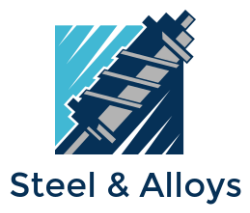High-Speed Steels
Welcome to our webpage dedicated to High-Speed Steels (HSS), a group of tool steels known for their outstanding cutting performance, high hardness, and excellent wear resistance. In this guide, we'll explore various types of high-speed steels, their different shapes and sections, production routes, and offered conditions for machining.
**Introduction to High-Speed Steels (HSS)**
High-Speed Steels are alloys of iron, carbon, and other elements such as tungsten, molybdenum, vanadium, cobalt, and chromium. These steels are specifically designed to withstand high temperatures and maintain their hardness at elevated cutting speeds, making them ideal for cutting tools, drills, milling cutters, and other applications where high wear resistance is required.
**Types of High-Speed Steels:**
1. M-2:
- M-2 is one of the most widely used general-purpose high-speed steels.
- It contains a combination of tungsten, molybdenum, and vanadium, providing excellent toughness and wear resistance.
- M-2 is suitable for a wide range of cutting tools and cold work applications.
2. M-35:
- M-35 high-speed steel contains additional cobalt, which enhances its red hardness and high-temperature properties.
- It is well-suited for applications requiring high heat resistance and toughness, such as twist drills and taps.
3. M-42:
- M-42 is a high-cobalt high-speed steel, offering superior hot hardness and wear resistance.
- It excels in high-speed cutting operations and is commonly used for making broaches and milling cutters.
4. T-1, T-2, T-3, T-4, T-5, T-6, etc.:
- These are various grades of high-speed steels with specific compositions tailored for different applications.
- Each grade offers a unique combination of hardness, toughness, and wear resistance.
**Shapes and Sections:**
High-Speed Steels are available in various shapes and sections to meet the diverse needs of different industries. Commonly available shapes include:
- Rounds
- Squares
- Flats
**Forms of High-Speed Steels:**
High-Speed Steels can be found in different forms, each processed to suit specific requirements:
1. Rolled:
- High-Speed Steels in rolled form are hot-rolled into desired shapes and sizes.
- This form is commonly used for standard tools and applications.
2. Forged:
- Forged high-speed steels are produced by shaping the heated metal through compression using forging dies.
- This form enhances the mechanical properties and provides better grain structure.
3. Bright:
- Bright high-speed steels undergo a bright annealing process, resulting in improved surface finish and reduced internal stresses.
- This form is preferred for applications where appearance and surface finish are critical.
**Size Range for Each Section:**
The size range for each section of high-speed steels varies depending on the specific grade and the manufacturing capabilities of the steel producer. Generally, these steels are available in a wide range of diameters, thicknesses, and lengths to accommodate diverse industrial needs.
**Production Routes:**
High-Speed Steels are produced using different production routes to achieve varying properties:
1. Non-Vacuum Degassed Route:
- This is a conventional production method where the steel is melted without vacuum degassing.
- It is suitable for standard applications that do not require extremely high purity.
2. Vacuum Degassed Route:
- The vacuum degassed route involves removing impurities through a vacuum degassing process, resulting in high-purity steel.
- This route is preferred for applications demanding superior performance and cleanliness.
**Machinable Conditions:**
High-Speed Steels are offered in various machinable conditions to meet specific machining and application requirements:
- As Rolled: Suitable for applications with less stringent machining needs.
- Annealed: Improves machinability and softens the steel for easier shaping.
- Normalized: Enhances uniformity in grain structure and machinability.
- Spheroidize Annealed: Increases toughness and formability, especially for cold work applications.
**Conclusion**
High-Speed Steels are a crucial group of tool steels used extensively in industries requiring high-performance cutting tools. Their diverse compositions, shapes, and forms offer a wide array of options to suit specific needs. Whether you need standard tooling or highly specialized cutting solutions, high-speed steels are sure to meet the demands of your most challenging applications. Should you have any inquiries or require further assistance, feel free to contact us.
